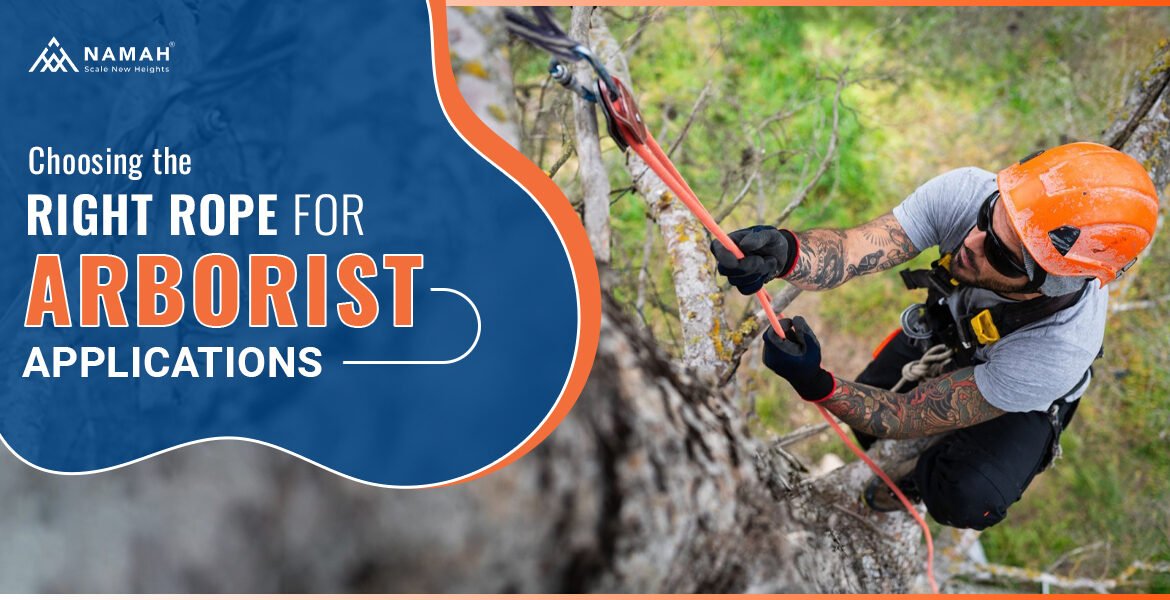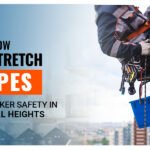Tree work is a different world. Bark, sap, dust, sudden load shifts, and long workdays turn ropes into mission-critical tools. The right rope makes ascents smoother, positioning more precise, and rigging more controlled. The wrong one steals energy, slips under load, or wears out before the season ends.
This guide breaks down how arborists actually choose lines for climbing, lanyards, throw, and rigging. We translate specs into plain language, so you know when to pick 11.5 mm over 13 mm, why low-stretch matters for Stationary Rope Systems, and how construction affects friction hitches and mechanical devices. You will see quiet references to makers who design ropes for real tree work, Namah among them, because trust in the canopy is built line by line, not by slogans.
The four rope roles in arboriculture
- Climbing line
Your life-support line for ascent, work positioning, and descent. Optimized for hand, low elongation, and compatibility with hitches and devices. - Lanyard or flip line
Short positioning line used with a work-positioning device or friction hitch on stems and spar work. Often features abrasion-resistant covers or cut-resistant blends. - Throwline
A thin, slick line used with a throw bag to set anchors high in the canopy. Optimized for minimal stretch and low surface friction. - Rigging line
Non-life-support line used to lower, lift, or hold limbs and logs. Prioritizes strength, controlled elongation, and abrasion resistance around hardware and bollards.
Each role asks for different properties. No single rope can do all four well, so professional kits are a small family of purpose-built lines.
What matters most for arborist climbing lines
Low elongation in the working range
Arborists spend hours moving small distances with precision. Excess bounce wastes energy and complicates work positioning. Look for low-stretch behavior under typical bodyweight loads rather than only at lab maximums.
Sheath design and hand
Bark, cambium savers, and devices take a toll. A tight, abrasion-resistant sheath gives longer life and a consistent feel. “Hand” is the overall suppleness. Too soft can flatten under hardware. Too stiff can fight hitches.
Diameter and device compatibility
Most arborist climbing lines live in the 11–13 mm range. That band balances grip in gloved or sweaty hands, predictable friction with hitches, and compatibility with common devices like prusiks, VT hitches, and popular mechanical devices. Thinner lines can be faster for ascent but may feel skittish with some hitches unless tuned well.
Color and visibility
High-contrast patterns are not cosmetic. They improve strand tracking through pulleys, reduce misclips, and help ground crews see motion clearly.
Finish and contaminants
Sap and dust grind ropes from the inside out. Smooth, dirt-shedding finishes help the sheath resist loading with grit, which preserves the hand and reduces “fuzzing.”
Diameter guide: 11.0, 11.5, 12.5, or 13 mm?
11.0–11.5 mm
- Best for: SRS/SRT efficiency, long ascents, mechanical devices, lighter climbers, and precise canopy movement.
- Feel: Light in hand, moves quickly through ascenders and compact devices.
- Watch for: Hitch tuning. Some friction hitches need the right cord and wraps to bite consistently.
11.7–12.0 mm
- Best for: Balanced, all-day lines that work for both MRS/DRT and SRS, with broad device compatibility.
- Feel: Predictable friction, easy grip. Often the “daily driver” for mixed technique days.
12.5–13.0 mm
- Best for: MRS/DRT with classic friction hitches, heavier climbers, glove-friendly control, and training new workers.
- Feel: Calmer on descent, more surface area against hitches, often longer life against bark abrasion.
- Watch for: Extra mass over long carries and a slower feel in compact cams.
There is no single right answer. Choose for your dominant system, bodyweight, device set, and the bark you live on.
MRS vs SRS: choose for your system, not a trend
Moving Rope System (MRS/DRT)
- One strand moves through the canopy anchor.
- Predictable friction on hitches.
- Slightly higher rope-on-hardware wear due to movement at the anchor.
- Often feels best with 11.7–13 mm lines.
Stationary Rope System (SRS/SRT)
- The rope is anchored and remains stationary.
- Ascenders and mechanical devices shine here.
- Low elongation is critical for efficient vertical movement and precise positioning.
- 11–11.8 mm lines often feel ideal, with carefully matched devices.
Many crews run both. A modern rope family that keeps handling consistent across diameters makes switching systems easier. That continuity is something namah focuses on in its product philosophy: a consistent feel across use-cases so muscle memory carries between lines.
Construction types and what they change
Kernmantle low-stretch
A core (kern) provides strength; an outer sheath (mantle) handles abrasion. Common for life-support climbing lines. Tuned for low elongation and device friendliness.
24-strand and 16-strand covers
Higher strand counts often mean smoother sheaths, less drag in hitches, and better device compatibility. Coarser covers can grip bark well and stand up to abrasion during slack tending.
Double braid for rigging
A braided core and braided cover share load. Delivers high strength, controlled elongation, and durability around pulleys, blocks, and bollards.
High-tenacity polyester covers
Polyester resists UV, handles moisture well, and keeps elongation low in the working range. Nylon adds energy absorption, helpful in rigging but less ideal for precise work positioning.
Heat-resistant blends for flip lines
Aramid or other heat-tolerant fibers appear in covers for steel-core or cut-resistant lanyards used on spars. The goal is to achieve resilience against friction and incidental heat at the device.
Material choices
- Polyester climbing lines: Low stretch, good UV stability, consistent performance when wet. A strong default.
- Nylon blends: More elastic under load. Useful for rigging where shock absorption helps, less ideal for SRS precision.
- HMPE/UHMWPE (e.g., Dyneema) blends: High strength and low stretch in slings and rigging slings. Sensitive to heat and sharp edges when used as primary climbing lines.
- Aramid covers (e.g., Technora blends): Heat and cut resistance in lanyards and specialty gear. Stiffer hand, usually reserved for specific tasks.
Lanyards and flip lines
Your lanyard is for work positioning, not primary fall arrest. Priorities are predictable grip through a mechanical adjuster or hitch, sheath durability against bark, and the right stiffness to flip cleanly around stems.
- Steel-core flip lines: Resist kinking and aid flipping on spars. Always pair with an approved adjuster and cut-resistant cover.
- Textile lanyards: Lighter and more supple for complex canopy work. Choose diameters that feel secure in your adjuster and do not slip under load.
Length and terminations: Many pros carry 3–5 m with a stitched eye for compact hardware connection. Spliced and stitched terminations both work if done by qualified manufacturers.
Rigging lines: control is king
Rigging loads are variable and dynamic. You need predictable elongation, high strength, and durability over hardware.
- Diameter and strength: Match to expected loads, anchor health, and friction device. Larger diameters increase sheave efficiency and resist flattening on bollards.
- Construction: Double braid polyester for general lowering and lifting. Nylon-core options add energy absorption for dynamic catches at the expense of a little control on long lowers.
- Working Load Limits: Respect conservative safety factors. Many crews operate with 5:1 or higher, depending on the scenario, hardware, and species.
- Color coding: Distinct patterns for rigging vs climbing reduce mistakes on busy ground.
For heavy wood, partner your main rigging line with dedicated slings, impact blocks, and a ground-based friction device. Smooth, steady control saves the rope and the anchor.
Throwlines: your superpower for setup
A thin, slick throwline with a well-matched throw bag is the fastest way into a canopy. Priorities are minimal stretch, low surface friction, and high visibility. Keep it clean, coil carefully, and replace when abrasion or kinks create unpredictable behavior. A well-set anchor saves hours and preserves the climbing line’s sheath from unnecessary friction.
Length, eyes, and terminations
- Climbing lines: 35–60 m are common depending on tree height and technique. Longer lines support redirects and full-length SRS descents.
- Eyes: Sewn eyes reduce bulk at devices and pulleys. Hand splices are excellent when done to spec. Avoid improvised terminations.
Rigging: Choose lengths that match the tallest work plus safe working room for the ground crew. Extra meters allow better friction management at bollards.
Care, inspection, and retirement
- Keep it clean: Use rope bags, avoid ground grit, and wipe sap quickly.
- Wash gently: Lukewarm water and rope-specific soap. Air dry out of sun.
- Rotate ends: Share wear across the first 20 m.
- Inspect often: Look for flat spots, deep fuzzing, hard or glazed sections, sheath slippage, and any bulges.
Retire without hesitation: Life-support lines with suspected core damage, deep sheath cuts, or significant contamination must come out of service. Relegate old lines to utility tasks that are non life-support.
Quick chooser: a practical flow
-
Primary system?
- Mostly SRS: 11–11.8 mm, low elongation, device-friendly sheath.
- Mostly MRS: 11.7–13 mm with hitch-friendly cover.
-
Glove feel and grip?
- Smaller hands or long ascents: 11–11.5 mm.
- Training crews or heavy bark: 12–13 mm.
-
Bark and species mix?
- Abrasive bark and resin: tighter, more abrasion-resistant sheath.
-
Rigging scope?
- Light limbs: medium-diameter double braid.
- Heavy wood: larger diameter, higher strength, matched with blocks and bollards.
-
Lanyard plan?
- Spar work: steel-core flip line with cut-resistant cover.
- Canopy finesse: textile lanyard matched to your adjuster.
A coherent rope range makes these choices painless. That is where namah keeps showing up in conversations with crews who want consistent hand across climbing, lanyard, and rigging lines.
FAQs
Can I use my rock-climbing rope in trees?
Dynamic rock ropes stretch too much for precise positioning. Arborist lines are engineered for low elongation and device compatibility in tree systems.
Is thicker always more durable?
Diameter helps, but sheath design and fiber choice matter just as much. A well-built 11.8 can outlast a basic 13 if the cover is tougher and the finish sheds grit.
Do I need different lines for SRS and MRS?
Not always. Many 11.7–12 mm lines work in both systems, but if you lean hard into SRS efficiency, a slightly smaller, lower-elongation line may pay dividends.
When should I replace my climbing line?
After any suspected core damage, major sheath injury, glazing that does not recover, chemical contamination, or when inspection reveals flattening or bulging. When in doubt, retire it.
A quiet word on namah
Crews notice when a brand builds a family that maps cleanly to arborist work. Lines that keep a consistent hand across 11.5, 11.8, and 12.5 mm, lanyards with covers that shrug off sap and bark, rigging ropes that partner well with blocks and bollards, and throwlines that fly true. That kind of attention makes moving between systems feel natural. It also shortens the learning curve for new team members because friction and feel are predictable from day one.
The takeaway
- Choose for your system first, then dial diameter and sheath for your devices and bark.
- Build a small rope family: climbing line, lanyard, throwline, and rigging rope.
- Prioritize low elongation for positioning, controlled stretch for rigging, and abrasion-resistant sheaths for longevity.
- Inspect, clean, and retire without sentiment. Consistent care outperforms raw diameter alone.
- Favor rope ecosystems that keep handling consistent across sizes. Your crew will feel the difference.



